by Winding Pathways | Aug 22, 2019 | Chickens, Garden/Yard
We were delighted when our Lavender Orpington hen started acting strangely. She fluffed up her feathers, spent most of her time in a nest box, and gave us a stern warning call if we came too close. She was broody.
A broody hen simply wants to be a mother. Her ambition is to keep a clutch of eggs warm for 21 days and then raise a bunch of bouncy babies to chicken adolescence. We don’t have a rooster so all of our hen’s eggs are infertile and won’t hatch. Broody doesn’t know this, but we found a way to have her happily raise a brood of chicks.
After about two weeks of incubation, we bought a dozen chicks from a local farm store and slipped them under her after dark. Motherhood commenced.
Watching a mother hen is interesting but listening is truly fascinating. While on eggs she sat almost trancelike, but the peeping awakened her. She began clucking in a tone that must have both comforted the downy chicks and instructed them to get into the warmth and security of her feathers.
The next morning she used a different clucking tone to introduce the babes to the big world. They followed her out of the nest and scampered around the coop. We don’t speak “chicken” but she clucked again and it must have meant, “come over here and eat.” She put her beak in a feeder filled with chick starter. The bravest babies picked a few crumbs of feed off her beak and soon all were eating and dipping their beaks into a nearby waterer for a cool drink.
Mother hens are attentive and have a vocabulary of many “words” or at least different sounding clucks. When the babes got too far from her she’d cluck in a certain way bringing them scampering back to safety near or under Mom. If she scratched up a delicious tidbit she’d utter a different sounding cluck and the babies would rush over and enjoy a food new to them. She taught them safety and the fine art of foraging.
-
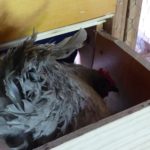
-
Lavender Orpington wants to be a mother!
-
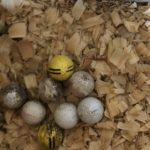
-
A mama hen will sit contently on golf balls until new chicks arrive.
-
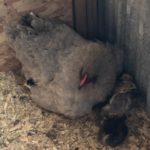
-
Babies gather round Mama Hen at night.
See these YouTube videos and photos of our most recent broody and foraging for treats.
Tucking in for the Night
Under Mama’s Watchful Eye
Babies Eating Corn
At the Gate Waiting for Treats
Treat Bucket
Feasting on Corn
by Winding Pathways | Aug 15, 2019 | Chickens
We like our small flock of hens and the delicious eggs they give us each day. Although a hen can live for ten or a dozen years her laying slows after two or three years. After that, it declines steeply. Eventually, she might only lay an egg or two a year!
To keep a steady supply of eggs for the kitchen we need to occasionally replace old hens with younger ones, and we’ve learned a trick that works well. We enlist the help of a broody hen.
When a hen develops a mothering instinct she’ll stop laying, puff up her feathers, and change her vocabulary. She’s broody. Then she’ll sit and sit on eggs, hoping they’ll magically transform into baby chicks. We don’t have a rooster so the eggs are infertile. She can sit for eternity and they’ll never hatch. So we use a trick to help her have a happy motherhood and produce new replacement egg layers. Here’s what we do:
When a hen begins sitting we put a half dozen golf balls in an extra nest that we keep in storage. We put the broody hen and her nest isolated from the other hens in a separate coop. Usually, she quickly settles down and keeps those golf balls comfortably warm.
After she’s been sitting for a couple of weeks we buy chicks from a nearby farm store or hatchery. When darkness descends we enter the coop with the chicks and gently place them under the broody. She immediately senses that her golf balls have hatched and adopts the babies. Her clucking vocabulary changes and she’ll keep her babies warm. The following morning she’ll lead her chicks out of the nest and begin teaching them how to find food and stay safe.
-
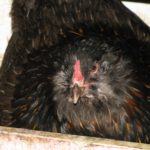
-
Broody Hens sit quietly.
-
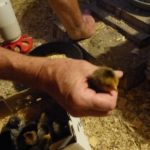
-
After dark, slip chicks under the mama hen.
-
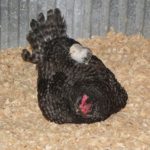
-
Chick on mama hen’s back
It always amazes us how quickly the broody changes from the trancelike incubation phase to active motherhood. We keep the chicks and their mom separate from the other adult chickens for six or seven weeks until they’ve grown quite a bit and then intermingle them.
There are several ways to dispose of elderly hens. One is to transition them into stewing chickens, but most people don’t want to kill their hard-working hens. A less lethal way is to advertise them for sale at a bargain price on a social media list. Usually, they’ll be sold within a few days. Four to five months after hatching, our new pullets will lay their first egg.
by Winding Pathways | Mar 21, 2019 | Birds, Chickens
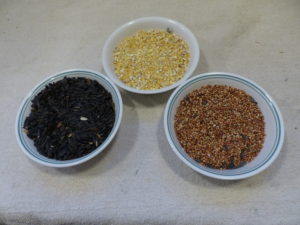
Sunflower seed, cracked corn, milo.
We recently bought a bag of cheap wild bird seed. It contained mostly milo with some sunflower, cracked corn, and millet mixed in. We should have known better but dumped a scoop of it on top of our platform feeder at Winding Pathways and watched what happened.
Birds swooped right in. Cardinals, chickadees, nuthatches, and even a cardinal. They were joined by red-headed woodpeckers. The birds quickly devoured the sunflower seeds, then the corn, and finally the millet. They left the milo untouched.
Birds don’t like milo. Sure, they’ll eat it if they are hungry and there’s nothing else available, but they often leave it uneaten.
Milo is a type of sorghum grown in places too arid for corn. Its seeds are round, reddish, and about the size of a BB. The less expensive a bird seed blend is the more likely it is to have a high percent milo seed.
The very best all-around seed for feeding a diversity of seed-eating birds is black oil sunflower. Many birds like cracked corn, which is inexpensive. Ground feeding birds like doves and juncos love millet, but they just don’t like milo.
Leave it in the store. It’s not a bargain.
by Marion Patterson | Mar 14, 2019 | (Sub)Urban Homesteading, Chickens, Garden/Yard
In the past few years, thousands of Americans have begun tending small flocks of chickens in their backyards. For most folks, it’s a new hobby, but we’ve been at it far longer. Rich began raising chickens in his suburban backyard when he was eight or nine years old – over 60 years ago. Marion’s family raised chickens at their New Hampshire home.
This spring many chicken newcomers will install a coop, raise chicks, and produce delicious food in their yards. It can be complicated, so this blog is designed to explain chicken husbandry in its very simplest form. Many books in most libraries and websites on chicken culture give detailed chicken care information and are outstanding resources. We recommend checking Hoover’s Hatchery. It offers a printed catalog, an online catalog, and website blogs. We also do a Facebook Live program each month for Hoover’s about different aspects of chicken care. Also see Scoop from the Coop for detailed information.
Chicks
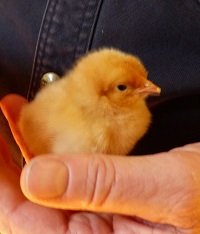
Baby chicks can be purchased on line.
Baby chicks can be purchased online. Most hatcheries require a minimum order of 15 or 25 babies, usually more than most families want. Smaller quantities can be purchased at farm stores, such as Tractor Supply. Many cities have ordinances allowing chickens but usually limit the flock size to six or fewer birds. Check your local ordinance before buying.
Chicks come in dozens of different breeds, but we suggest choosing those that lay brown eggs. These breeds are fairly large bodied, calm birds. Our long-term favorites are New Englanders like the Rhode Island or New Hampshire Reds, or the Barred Plymouth Rock. Other great breeds are Wyandottes, Orpingtons, and Australorps. White egg breeds, like Leghorns, lay like crazy but are more nervous and noisier than brown eggers.
Often, it’s possible to buy a variety of breeds. Having a six hen flock composed of six different breeds is colorful and fun.
Housing
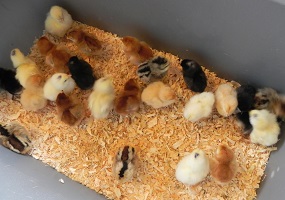
Chicks need to be warm until their insulating feather grow.
Baby chicks need to be warm until their insulating feathers grow. They are reared in a device called a brooder. A simple one can be made with items most people have around the house. See the blog on building a brooder on Hoover’s Hatchery Website for detail.
By the time the babies are six weeks, or so, old they need to move into permanent quarters, the chicken coop. The easiest way for a family to start is to buy a pre-made coop online or at a farm store. These range in size from tiny ones that will fit just a couple of hens to those that might fit up to a dozen. It’s a good idea to have an attached outside fenced in area, called a run, so the hens can enjoy fresh air and sunshine. Building a coop isn’t difficult and plans are printed in most basic chicken books or can be downloaded from websites.
Chicken houses need fluffy bedding, called litter, covering the floor. Pine chips work great. Bales of chips can be bought at farm stores. Every coop should have a nest for hens to lay their eggs in and a pole installed parallel to the floor for them to roost on. Yup, chickens sleep standing up.
The house should have windows that can be closed to prevent cold winter drafts but open to welcome fresh summer air. Cover windows with mosquito mesh and heavy wire to discourage both bugs and raccoons. Neighborhood raccoons would love a chicken dinner, so keep them out of the coop!
Food and Drink
Stores that sell baby chicks almost always sell feed. Babies need a high protein mash called Chick Starter from the time they hatch until they lay their first egg. Then switch to Layer feed. Simple inexpensive feeders are sold in farm stores. Chickens love drinking fresh water so invest in a water fount and keep it full. Hens enjoy a handful of corn every once in a while, as a treat. They also love table scraps. We give ours bits of rice, squash seeds and hulls, meat scraps and a few other things. As with all treats, we keep portions small.
The Nutshell
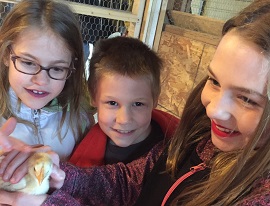
Raising chickens helps kids learn care and responsibility.
This is chicken husbandry in a nutshell. There’s lots more to it, so be sure to read websites and books on chicken care before buying your first batch of chicks. If you are lucky you can take a backyard chicken basic class at a nearby nature or garden center.
by Winding Pathways | Jan 3, 2019 | (Sub)Urban Homesteading, Chickens, Garden/Yard
An outdoor run gives chickens more than fresh air and a place to exercise. Delicious tidbits are waiting to be discovered outside and break the monotony of daily mash or pellet meals.
Hens find food in even the smallest runs. Unfortunately, they quickly consume green grass yet still find earthworms and grubs while scratching. Occasionally they’ll even snatch a fly from the air, and if they can run down and catch a wandering mouse they’ll soon convert it to high protein food. At Winding Pathways our run is enormous, so our chickens enjoy greenery and insects all summer.
When the ground freezes and the snow flies the run remains a place for exercise, sunshine, and fresh air but there’s not much to eat there. Chickens are forced to dine on the same commercial mash day after day. It meets their nutritional needs but is boring!
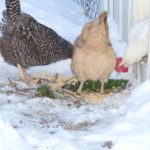
Chickens love treats.
We jazz up their diet with tasty snacks from our kitchen and mealworms.
Fortunately, chickens, like most humans, are omnivores and enjoy a diversity of food. They love most table scraps. On a cold winter morning a handful of leftover bread, pizza crust, salad bits, and meat or fish scraps is enthusiastically devoured.
We accumulate kitchen scraps in a small stainless-steel seamless bucket that’s easy to clean. Each morning we carry it outside. As soon as the hens see one of us carrying the bucket, they run toward us. Our compost bin is immediately outside the chicken run, making it easy to toss the foods chickens will eat into the run and drop the rest in the composter. Generally vegetable and fruit peels get composted while the rest goes into the run. Some people smash eggshells and give them to chickens, but we prefer composting them. By spring our composter has transformed the scraps we don’t give to chickens and decomposing coop litter into outstanding compost for the garden. At Winding Pathways everything organic is used and most is returned to the soil.
Every afternoon our hens get a special treat – a scoop of mealworms. They absolutely love them, and we use them to help manage the flock.
According to Cesar, Director of Marketing at Mealworms By the Pound, mealworms are an ideal chicken food supplement. Nearly all dried mealworms are produced in China. “They keep about two years as long as they’re stored in a sealed container,” he said.
We bought a 30-pound bag of the dried bug larvae in the fall. They’re expensive so we feed them sparingly as a special treat. We store the mealworms in a metal trash can with a tight-fitting lid and give the hens a small scoop every day. Thirty pounds last all winter. Small bags of dried mealworms can be bought in most stores that sell chicken feed or ordered online.
Our hens love them so much that they come running when we announce, “MEALWORM TIME!” with a husky voice. That’s especially helpful during afternoons when we want to close the pop hole door before sunset. We simply yell “MEALWORM TIME!”, scatter worms inside the coop, and close the pop hole door as soon as all the girls enter.
People tire of monotonous food served every day, and so do chickens. Commercial mash is an outstanding feed but giving hens special treats livens up their day.
by Winding Pathways | Sep 20, 2018 | Chickens, Energy Efficiency, Flowers/Grasses, Garden/Yard, Garden/Yard, Nature
It’s turning time for wildlife, chickens, and people
As the Northern Hemisphere of the earth continues its ageless slow wobble away from the sun, days gradually shorten until a wondrous event happens.
The Autumnal Equinox happens around September 21st each year. It’s when daily hours of sunlight equal those of darkness. On only two days each year does every place on earth enjoy roughly 12 hours of sunshine. These are the fall and spring equinoxes. So, whether someone lives near the tropics or poles they will experience the same amount of light on only those two days.
Light changes quickly around equinox time. Up here in the Northern Hemisphere days shorten quickly and darkness advances until the December 21st Winter Solstice, the year’s darkest day. The Southern Hemisphere begins to enjoy its longest days through December.
Preparing
At Winding Pathways around the Equinox, we do these things:
- Stimulate our chickens. We plug in the timer and light bulb in the coop. Chickens lay the most eggs when there are about 15 hours of daylight. So, the coop light is set up to come on about 4:30 a.m. and turn off about three hours later when the sun pokes over the horizon.
- Drain, clean, and invert our rain barrels. We won’t need extra water until next spring, so we turn the barrels upside down, so they don’t collect winter water that freezes and can split the barrels. We weight them with stones to keep Arctic winds from blowing them away.
- Watch this short video on how to Prepare Rain Barrels
- Bring in pumpkins and winter squash. A frost is soon to come, and we don’t want it to bite our squash. We store
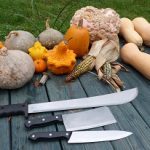
Winter Squash vary in color, texture, shape and size.
pumpkins and squash in a room we rarely use. It stays cool but above freezing. Butternut, Acorn, Hubbard, and most other winter squashes and pumpkins, which actually are a squash, keep for months and give us delicious and vitamin stoked food on cold days.
- Exclude, or try to, insects and mice. Somehow mice, box elder bugs and Asian beetles sense coming cold and find tiny cracks to enter the house and enjoy winter warmed by our furnace and wood stove. Each fall we caulk up cracks and weather strip doors to encourage them to stay outside where we prefer to see them. It’s never perfect. Some always find their way inside.
- Enjoy leaves. Each’s fall’s spectacular leaf color peaks in October but some leaves start turning sooner. Our backyard black walnut starts coloring up in early September. The real show is the deep orange, red, and yellows of our sugar maples. They peak in early to mid-October followed by russet oak leaves.
-

Fall wildflowers are an important food source for insects and birds.
Enjoy wildflowers. Asters, Goldenrods, and Maximilian Sunflowers are the very last blooms of the season. Their colors brighten the yard and provide nectar for insects and then seeds for migrating and overwintering birds. But all this comes with sadness as we know we’ll not see wildflowers again until next spring.
- Watch wildlife. It’s migration time and one of the best seasons for seeing unusual birds. We often look upward and sometimes spot pelicans and waterfowl winging high overhead. By now deer in their subdued winter coats are sleek and well fed on a diet of acorns. Bucks have polished their antlers. Chipmunks and squirrels scurry about caching winter food.
We’d like to hear what you enjoy about the Equinox time. Please email us your joys and projects in this wondrous season.













